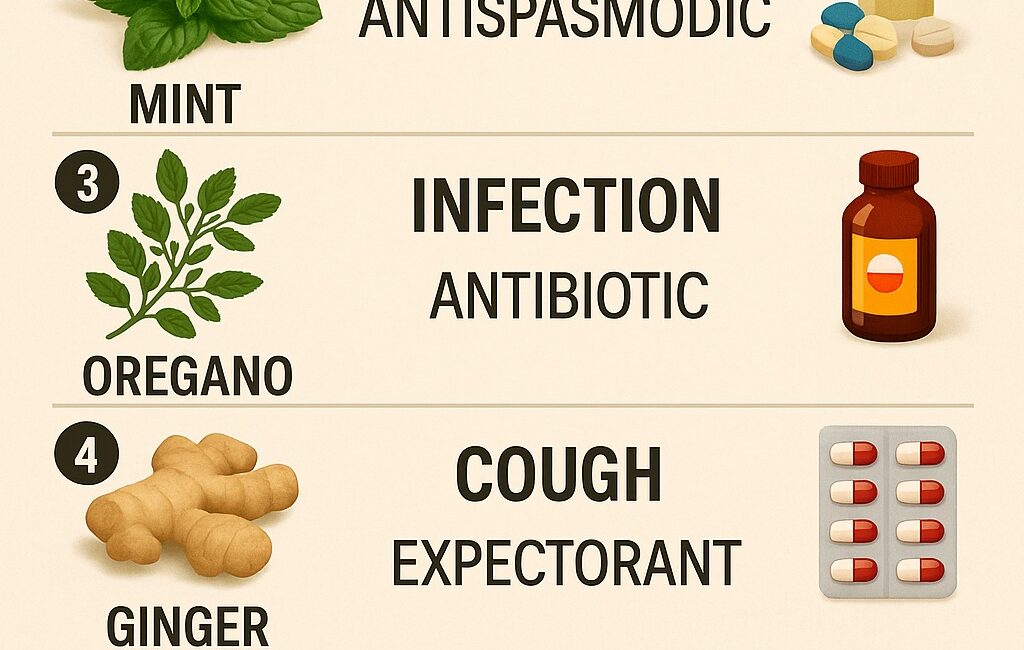For thousands of years, herbs have been at the heart of natural healing traditions worldwide. From ancient Ayurveda and Traditional Chinese Medicine to European folk remedies, plants have been valued not only for their flavors but for their remarkable therapeutic qualities. Today, scientific research increasingly validates what our ancestors knew intuitively: certain herbs contain potent bioactive compounds that can alleviate ailments, boost health, and even prevent disease.
In this article, we explore six widely used medicinal herbs—basil, mint, oregano, ginger, rosemary, and thyme. We’ll dive deeply into their traditional uses, modern scientific evidence, and most importantly, the precautions needed to use them safely. Whether you’re a health enthusiast or just curious about natural remedies, understanding these herbs can empower you to harness their benefits responsibly.
1. Basil (Ocimum basilicum)
Overview and Traditional Uses
Basil, often referred to as the “king of herbs,” is a fragrant, leafy plant belonging to the mint family (Lamiaceae). It is a staple in Mediterranean and Southeast Asian cuisines, prized for its sweet, peppery flavor and aroma. Beyond the kitchen, basil has been traditionally used to ease digestive issues, relieve pain, and treat infections.
In Ayurvedic medicine, basil—particularly Holy Basil (Ocimum sanctum)—is revered for its adaptogenic properties, helping the body resist stress and inflammation. While Holy Basil is a distinct species, this article focuses on the common sweet basil, which also offers many health benefits.
Key Active Compounds
Basil contains a variety of bioactive compounds, including:
- Eugenol: A phenolic compound with anti-inflammatory and analgesic effects.
- Linalool: Known for its calming and antimicrobial properties.
- Rosmarinic acid: Potent antioxidant and anti-inflammatory agent.
- Flavonoids: Support immune function and combat oxidative stress.
Uses and Benefits
Natural Pain Relief
Eugenol is the most studied compound in basil for pain relief. It inhibits enzymes like cyclooxygenase (COX), similar to how some over-the-counter pain medications work, helping reduce inflammation and pain. This makes basil useful for headaches, muscle tension, and joint discomfort, including mild arthritis symptoms.
Liver Support
Preliminary research suggests basil can support liver function by reducing oxidative damage, which may help detoxify harmful substances.
Antibacterial Properties
Basil exhibits mild antibacterial effects against common pathogens such as Staphylococcus aureus and E. coli, potentially helping with minor infections or skin conditions.
Digestive Aid
Basil’s carminative properties help reduce gas and indigestion.
Precautions
- Pregnancy: Avoid high doses of basil supplements during pregnancy, as some compounds might stimulate uterine contractions.
- Blood Pressure: Basil may lower blood pressure; people on antihypertensive medications should monitor their blood pressure closely.
- Allergic Reactions: Those sensitive to the mint family (Lamiaceae) may experience allergic reactions like skin rash or respiratory symptoms.
How to Use Basil
- Fresh basil leaves in salads or cooked dishes.
- Basil tea for soothing digestive discomfort.
- Basil essential oil (diluted) for topical pain relief, but avoid direct skin contact with undiluted oil.
2. Mint (Mentha spp.)
Overview and Traditional Uses
Mint is a popular herb known for its refreshing aroma and cooling sensation. There are many species, including peppermint (Mentha piperita) and spearmint (Mentha spicata), both widely used medicinally. Mint has been used for centuries as a digestive tonic, breath freshener, and respiratory aid.
In Traditional Chinese Medicine, mint clears heat and soothes the liver, while Western herbalism often emphasizes its antispasmodic and carminative actions.
Key Active Compounds
- Menthol: Provides the characteristic cooling effect, soothes muscles, and opens nasal passages.
- Menthone: Contributes to the minty aroma and therapeutic effects.
- Flavonoids and polyphenols: Offer antioxidant benefits.
Uses and Benefits
Digestive Support
Mint relaxes the smooth muscles of the gastrointestinal tract, relieving spasms, cramps, bloating, and indigestion. This is particularly helpful for conditions like Irritable Bowel Syndrome (IBS), where muscle spasms cause discomfort.
Respiratory Relief
Menthol acts as a mild decongestant, clearing nasal passages and soothing sore throats, making mint a common ingredient in cough remedies.
Oral Health
Mint’s antimicrobial properties help freshen breath and reduce oral bacteria.
Precautions
- Acid Reflux: Mint may relax the lower esophageal sphincter, potentially worsening acid reflux or heartburn in susceptible individuals.
- Infants: Avoid giving menthol products to babies, as it can cause breathing difficulties.
- Medication Interactions: Mint may interfere with antacids or acid reducers.
How to Use Mint
- Mint tea to ease digestion or freshen breath.
- Chewing fresh mint leaves.
- Peppermint oil capsules (enteric-coated) for IBS symptom relief.
- Mint essential oil (diluted) for topical muscle relief.
3. Oregano (Origanum vulgare)
Overview and Traditional Uses
Oregano is more than a pizza herb—it’s a powerhouse of medicinal compounds with a long history of use in Mediterranean and Middle Eastern folk medicine. Traditionally, oregano was used to treat respiratory infections, digestive complaints, and skin conditions.
Key Active Compounds
- Carvacrol: The primary antimicrobial compound.
- Thymol: An antiseptic and antioxidant.
- Rosmarinic acid: Anti-inflammatory and immune modulating.
Uses and Benefits
Natural Antibiotic
Oregano is a strong antimicrobial herb effective against bacteria, viruses, and fungi. Its carvacrol content has been shown to kill Staphylococcus aureus, E. coli, Candida albicans, and more. This makes oregano a promising natural remedy for infections.
Antioxidant Support
Oregano’s rich antioxidant content helps neutralize free radicals, reducing oxidative stress and supporting overall health.
Respiratory and Digestive Health
It supports respiratory tract health by easing congestion and cough and promotes digestive balance.
Precautions
- Essential Oil: Oregano essential oil is very concentrated and can cause skin irritation if applied undiluted.
- Blood Clotting: Oregano may interfere with blood clotting; caution is advised for people on anticoagulants.
- Pregnancy: Avoid high doses or concentrated forms during pregnancy.
How to Use Oregano
- Fresh or dried oregano as a culinary herb.
- Oregano oil capsules for immune support.
- Diluted oregano essential oil for topical use (skin infections).
4. Ginger (Zingiber officinale)
Overview and Traditional Uses
Ginger is one of the most widely used medicinal herbs worldwide. Revered in Ayurveda, Traditional Chinese Medicine, and Western herbalism, ginger is famous for its warming, digestive, and anti-inflammatory properties.
It is commonly used to combat nausea, improve circulation, and soothe respiratory ailments.
Key Active Compounds
- Gingerols: Anti-inflammatory and antioxidant compounds.
- Shogaols: More potent derivatives formed during drying and cooking.
- Zingerone: Provides the sweet-spicy flavor and additional health effects.
Uses and Benefits
Cough and Congestion Relief
Ginger acts as an expectorant, helping to clear mucus from the respiratory tract. It also soothes sore throats and reduces inflammation.
Anti-Nausea
Ginger is widely used to relieve nausea from motion sickness, pregnancy (morning sickness), chemotherapy, and surgery.
Pain and Circulation
Ginger reduces muscle and menstrual cramps and improves blood circulation, which supports cardiovascular health.
Precautions
- Blood Thinning: Ginger can thin the blood; avoid high doses before surgery or if taking blood-thinning medications.
- Heartburn: Excessive intake may cause stomach upset or heartburn.
- Diabetes Medication: Ginger may lower blood sugar; monitor glucose if diabetic.
How to Use Ginger
- Fresh ginger tea or added to meals.
- Ginger supplements for nausea.
- Ginger essential oil (diluted) for topical pain relief.
5. Rosemary (Rosmarinus officinalis)
Overview and Traditional Uses
Rosemary is a fragrant herb native to the Mediterranean region, long used as a culinary spice and medicinal plant. Traditionally, rosemary was used to improve memory, ease pain, and support digestion.
It has stimulating and antioxidant properties that make it valuable for brain health and circulation.
Key Active Compounds
- Carnosic acid: Potent antioxidant.
- Rosmarinic acid: Anti-inflammatory and neuroprotective.
- 1,8-cineole: Respiratory stimulant.
Uses and Benefits
Nausea and Motion Sickness
Rosemary has antiemetic properties, helping to reduce nausea and vomiting.
Memory and Cognitive Function
Studies suggest rosemary may enhance concentration, memory, and alertness, possibly due to its antioxidant effects on brain cells.
Pain Relief
Rosemary relieves muscle and joint pain and supports circulation, helping with stiffness and soreness.
Precautions
- Essential Oil: Not for internal use in concentrated form.
- Blood Pressure: May raise blood pressure in some individuals.
- Pregnancy: Avoid high doses or concentrated forms.
How to Use Rosemary
- Fresh rosemary in cooking.
- Rosemary tea for nausea or digestion.
- Diluted essential oil for topical pain relief.
6. Thyme (Thymus vulgaris)
Overview and Traditional Uses
Thyme has a long history in herbal medicine, used to treat respiratory conditions, infections, and digestive problems. It is especially known for its antiseptic and expectorant qualities.
Key Active Compounds
- Thymol: A strong antiseptic and antifungal.
- Carvacrol: Antimicrobial and anti-inflammatory.
- Flavonoids: Support immunity.
Uses and Benefits
Respiratory Health
Thyme is highly effective for coughs, bronchitis, and sore throats, helping to loosen mucus and kill bacteria.
Immune Support
Thyme stimulates natural immunity and helps prevent infections.
Antimicrobial
Rich in thymol, thyme kills harmful microbes, making it useful in both internal infections and topical applications.
Precautions
- Essential Oil: Avoid excessive use; can irritate mucous membranes.
- Pregnancy: Not recommended in medicinal doses.
- Drug Interactions: May interact with thyroid or blood pressure medications.
How to Use Thyme
- Fresh or dried thyme in cooking.
- Thyme tea for respiratory support.
- Diluted essential oil for topical antiseptic use.
Final Thoughts
The natural world offers an incredible pharmacy, and these six herbs—basil, mint, oregano, ginger, rosemary, and thyme—demonstrate the healing power plants can hold. They support vital body systems: reducing pain and inflammation, aiding digestion, fighting infections, and boosting immunity.
However, natural does not mean risk-free. It’s crucial to use herbs with knowledge and caution. Pay attention to doses, possible interactions with medications, and contraindications such as pregnancy. When in doubt, consulting a healthcare professional or qualified herbalist ensures you reap benefits safely.
Tips for Using Medicinal Herbs Safely
- Start with small doses and monitor your body’s response.
- Use fresh or dried herbs as food or tea for mild, daily support.
- Avoid concentrated essential oils internally unless supervised by a professional.
- Be aware of allergies, especially if you have sensitivities to related plants.
- Never replace prescribed medication with herbal remedies without medical advice.
Harnessing the power of these herbs can be a beautiful addition to your health routine. They connect us to ancient wisdom and modern science, reminding us that nature is often the best healer.




